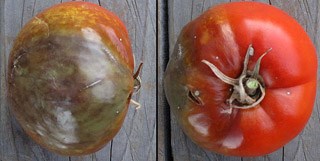Question:
We had terrible blight on our tomatoes this year, so I ended up throwing out lots of little tomatoes. Does blight affect pole beans as well or any other vegetables? What can be done about it so that we don’t have the same problem next year?
– Heidi Naman, by email
Answer:
Pole beans don’t get blight, but potatoes do. The last two summers have been so warm and dry, it’s been easy to harvest good crops of potatoes. But in a normal year with sporadic rain, many potato plants have blight by the beginning of August.
Peppers can get late blight but usually don’t. Eggplants are also said to be susceptible.
Blight is a fungal infection that blows into gardens on rainy winds or splashes up from infected soil. It thrives on wet foliage.
That’s why the usual advice is to grow tomatoes under cover: in greenhouses, or outside under polyethylene tunnels or under south or west wall roof overhangs. Keeping tomato plants dry definitely stops blight and enables you to grow most any tomato you wish, including heritage varieties.
But not everyone has cover available. People with no shelter for tomatoes can get good harvests outside by growing blight-resistant tomatoes. When their roots are in natural soil, tomatoes grow fast and produce massive crops.
The oldest blight-resistant variety is the large-fruited Legend, which is sometimes sold as a transplant in garden centres. Breeding of blight-resistant tomatoes is conventional (not GMO).
This and the newer blight-resistant varieties can be grown from seed. Gardeners who start their own transplants can harvest big crops of tomatoes by summer’s end. Blight on these varieties starts very late and moves very slowly.
Blight-resistant varieties I grew this year include the cherry tomato Mountain Magic, the paste-type Roma VF, and the beefsteak-type Defiant.
Only recently have these seeds become commercially available, and not everyone has been offering them. This year I bought mine online from Veseys (www.veseys.com). Grown outside, tomatoes are somewhat later to ripen, but quantities are immense, and with blight-resistant tomatoes the plants are still producing when blight-stricken tomatoes have given up.
By the end of September all my tomatoes were black with blight on the older stems but still had fresh, green new stems. By mid-October the new stems were still blight-free, and so was the remaining green fruit which had to be ripened inside.
Tomatoes are easy to freeze (just wash them, dry them and drop them into a plastic bag). Once frozen, their skin lifts off easily if they’re held under hot, running water.
Anne Marrison is happy to answer gardening questions sent to [email protected].



